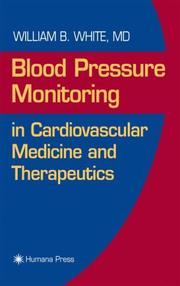| Listing 1 - 5 of 5 |
Sort by
|
Dissertation
Abstract | Keywords | Export | Availability | Bookmark
 Loading...
Loading...Choose an application
- Reference Manager
- EndNote
- RefWorks (Direct export to RefWorks)
Baroreflex --- Blood Pressure --- Heart Rate --- physiology
Dissertation
Year: 2001 Publisher: Liège Université de Liège
Abstract | Keywords | Export | Availability | Bookmark
 Loading...
Loading...Choose an application
- Reference Manager
- EndNote
- RefWorks (Direct export to RefWorks)
Embryonic and Fetal Development --- Heart Rate --- Heart Failure --- physiology --- physiopathology
Article
Abstract | Keywords | Export | Availability | Bookmark
 Loading...
Loading...Choose an application
- Reference Manager
- EndNote
- RefWorks (Direct export to RefWorks)
A history form was sent to owners of 103 horses with trailer problems to determine what types of problems with trailering the horses exhibited, as well as the techniques the owners had used to mitigate the problem. Horses had problems with loading (53.4%) and traveling (51.5%). Of the horses who exhibited problems during travel, most had problems when the vehicle first began to move (53%) or when it went around a curve (47%). Less than half the horses (28.2%) had been cured by the methods the owners used. Breed differences in type of problems, in incidence of multiple problems, and in improvement were compared. There were no statistical differences in breed representation, either overall, or for any one particular problem or combination of problems. Quarter Horses, Thoroughbreds, and Arabians were the most commonly presented breeds and the most common breeds at the time of the survey. No breed was more likely to be cured/improved or not. Orientation in the trailer and association of the trailer with aversive experiences may be important components of the etiology of trailering problems
Association. --- Behavior. --- Boxes. --- Breed. --- Direction. --- Experience. --- Heart-rate. --- History. --- Horse. --- Horses. --- Mares. --- Method. --- Orientation. --- Prevalence. --- Responses. --- Road transport. --- Slaughter. --- Stress. --- Survey. --- Thoroughbred. --- Thoroughbreds. --- Time. --- Trailer.
Article
Abstract | Keywords | Export | Availability | Bookmark
 Loading...
Loading...Choose an application
- Reference Manager
- EndNote
- RefWorks (Direct export to RefWorks)
Several studies have attempted to determine the effects of orientation on a horse's ability to maintain balance during transportation. The results have often been contradictory because of differences in trailer design and lack of simultaneous comparisons. In this study, three replications of two forward-facing and two rear-facing horses were transported at the same time over a standardized course to allow for simultaneous comparisons. Each animal's total forward and backward motion during transport was calculated to estimate the effect of orientation on the horses' ability to maintain balance. The course consisted of four laps around a 3.6-km rectangular course, each lap reversing direction, totaling 14.4 km. To mimic realistic travel, the course had artificial bumps, three turns (90 degrees, 45 degrees, and 135 degrees), five straight-aways, and a hard stop at the end of each lap. Four horses were transported over the course in 3.7 m x 2.4 nt stalls mounted in-line on a 16-m long commercial straight-deck trailer (16 wheels). At the end of the first run (four laps), the orientation of each horse, two forward and two rear-facing, was reversed for a second run. Twelve horses were transported in each of the two orientations. Movement was recorded using video cameras positioned perpendicular to the horse's side. Movement while forward-facing ranged from 4.75 to 34.48 m, averaging 12.95 m; when rear-facing, movement ranged from 8.13 to 35.21 m, averaging 16.99 m, and was not statistically influenced by orientation (P = 0.1219) due to high variation. Certain horses did demonstrate a superior ability to maintain balance in a particular orientation. Thus individual characteristics and other factors may play a larger role than orientation alone in the ability of horses to maintain balance during transport. (C) 2001 Elsevier Science B.V. All rights reserved
Ability. --- Animal transport. --- Animal. --- Artificial. --- Boxes. --- Design. --- Direction. --- Heart-rate. --- Horse. --- Horses. --- Motion. --- Movement. --- Orientation balance. --- Orientation. --- Play. --- Stress. --- Time. --- Trailer. --- Transport. --- Transportation stress. --- Variation. --- Video.

ISBN: 0896038408 Year: 2001 Publisher: Totowa (N.J.) : Humana press,
Abstract | Keywords | Export | Availability | Bookmark
 Loading...
Loading...Choose an application
- Reference Manager
- EndNote
- RefWorks (Direct export to RefWorks)
Ambulatory blood pressure monitoring. --- Blood Pressure Monitoring, Ambulatory. --- Blood Pressure --- Blood pressure. --- Cardiovascular Diseases --- Cardiovascular system --- Chronobiology. --- Circadian rhythm --- Circadian rhythms. --- Heart Rate. --- Hemodynamic monitoring. --- Hypertension --- Hypertension. --- Physiology. --- Physiopathology. --- Diseases --- Diagnosis. --- Therapy.
| Listing 1 - 5 of 5 |
Sort by
|

 Search
Search Feedback
Feedback About UniCat
About UniCat  Help
Help News
News